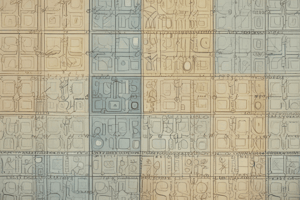Podcast
Questions and Answers
What is the probability of producing offspring with green eyes in a cross between two individuals with the genotypes (X/Y)?
What is the probability of producing offspring with green eyes in a cross between two individuals with the genotypes (X/Y)?
25%
Explain the significance of Punnett squares in understanding complex genetic crosses.
Explain the significance of Punnett squares in understanding complex genetic crosses.
Punnett squares help break down problems into smaller parts, allowing for independent analysis before combining the results. They are essential for tackling complicated genetic crosses involving multiple genes or alleles.
How do Punnett squares aid in teaching essential concepts in Mendelian genetics and probability?
How do Punnett squares aid in teaching essential concepts in Mendelian genetics and probability?
Punnett squares play a vital role in teaching inheritance patterns, probability, pedigrees, and chi-square statistics. They provide insights into genetics research and analysis.
What is the probability of producing offspring with blue eyes in the same cross between two individuals with the genotypes (X/Y)?
What is the probability of producing offspring with blue eyes in the same cross between two individuals with the genotypes (X/Y)?
How does analyzing the ratio of each type of gamete contributed by parents help determine the probability of genotypes in offspring?
How does analyzing the ratio of each type of gamete contributed by parents help determine the probability of genotypes in offspring?
Flashcards are hidden until you start studying
Study Notes
Understanding Punnett Squares: Mendelian Genetics and Probability
Punnett squares are a valuable tool used to predict the outcomes of genetic crosses, providing insights into the expected genotypes and phenotypes of the offspring. Developed by Ronald Fisher, Punnett squares help educators and researchers alike grasp the principles behind Mendelian genetics and probability in the context of genetics. Let's explore how Punnett squares function and their applications in understanding hereditary patterns and predicting genetic outcomes.
The Basics of Punnett Squares
Punnett squares are used to predict the probability or likelihood of specific genetic outcomes based on a given cross. They measure the frequency of different genotypes that could be produced by the combination of two parental genotypes. A simple example using eye color can illustrate this concept: green eyes being dominant and blue eyes recessive. Here's how it works:
- Identify the alleles for each gene. In this case, we have
big G(dominant) andlittle g(recessive). - Write down the four possible combinations in a square:
- Dominant homozygous (both parents contribute the same dominant allele):
Big G Big G - Homozygous recessive (parents both contribute the same recessive allele):
Little g Little g - Heterozygous (one parent contributes a dominant allele and one contributes a recessive allele):
Big G Little g
- Dominant homozygous (both parents contribute the same dominant allele):
- Determine the probability of obtaining each genotype by analyzing the ratio of each type of gamete contributed by the parents. For instance, if there is a 50% chance of getting a dominant allele from each parent, then there is a 25% chance of producing offspring with either of the two heterozygous genotypes. Similarly, there is a 12.5% chance of getting an individual with the heterozygous phenotype (green eyes), as shown below:
X
------------------
| | | | |
Y | Y | G | g |
| | G | G | g |
------------------
Z
In this Punnett square:
- The upper-left square represents the dominant homozygous genotype
Big G Big G. - The lower-right square represents the recessive homozygous genotype
Little g Little g. - The remaining squares represent heterozygous genotypes
Big G Little gand their reverse counterpartLittle g Big G.
Each of these four quadrants has an equal probability of occurring, which means they all have a 25% chance of being observed in the offspring's phenotype. Thus, if we cross two individuals with the (X/Y), we can expect a ratio of approximately 25% green eyes (dominant homozygotes), 25% blue eyes (recessive homozygotes), and 50% green/blue eyes (heterozygotes).
Applications of Punnett Squares in Mendelian Genetics and Probability
Punnett squares are not only useful for understanding simple genetics problems but also for more complex genetic crosses involving multiple genes or alleles. By breaking down a problem into smaller parts and analyzing each part independently before combining them, we can tackle even the most complicated crosses. This technique is particularly helpful when dealing with crossing types that involve multiple heterozygous parents, such as diploid organisms with many pairs of homologous chromosomes carrying different allele combinations.
Moreover, Punnett squares play a crucial role in teaching essential concepts related to Mendelian genetics, probability, pedigrees, and chi-square statistics, providing educators and students with valuable insights into key aspects of genetics research and analysis. They enable us to understand the principles underlying inheritance patterns and predict possible outcomes based on given genetic information.
Studying That Suits You
Use AI to generate personalized quizzes and flashcards to suit your learning preferences.




